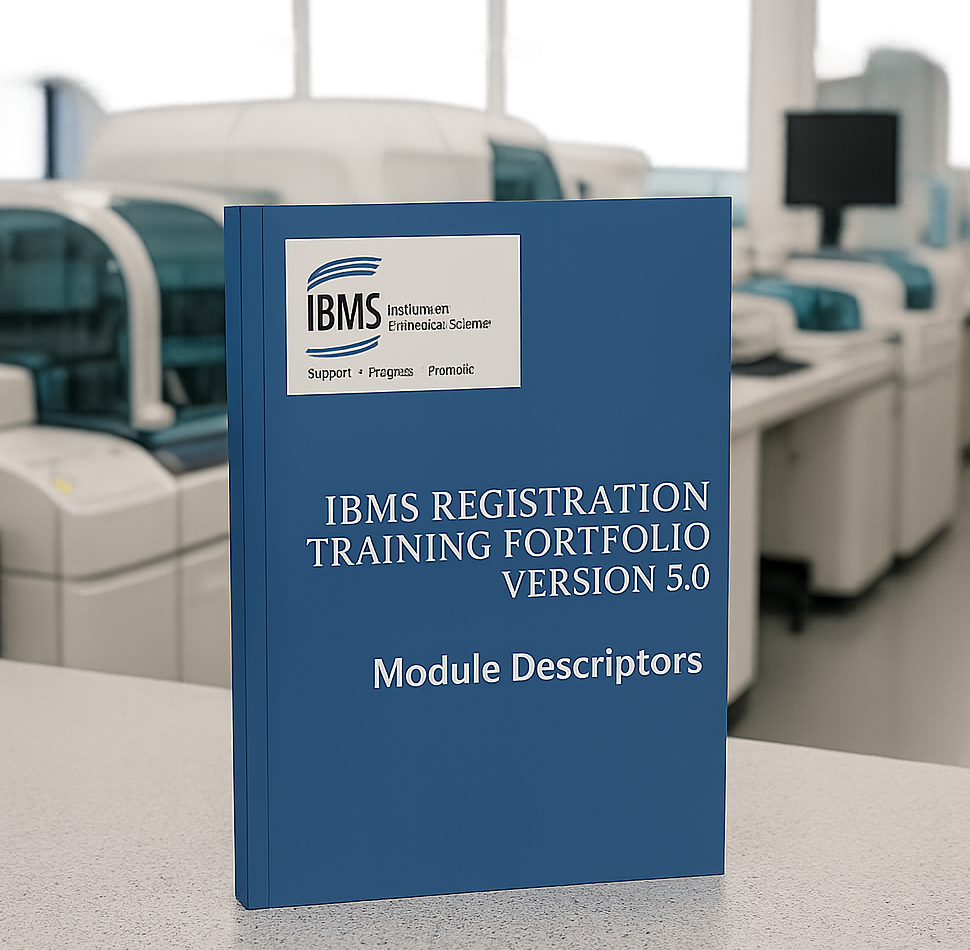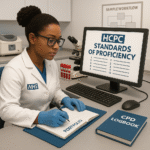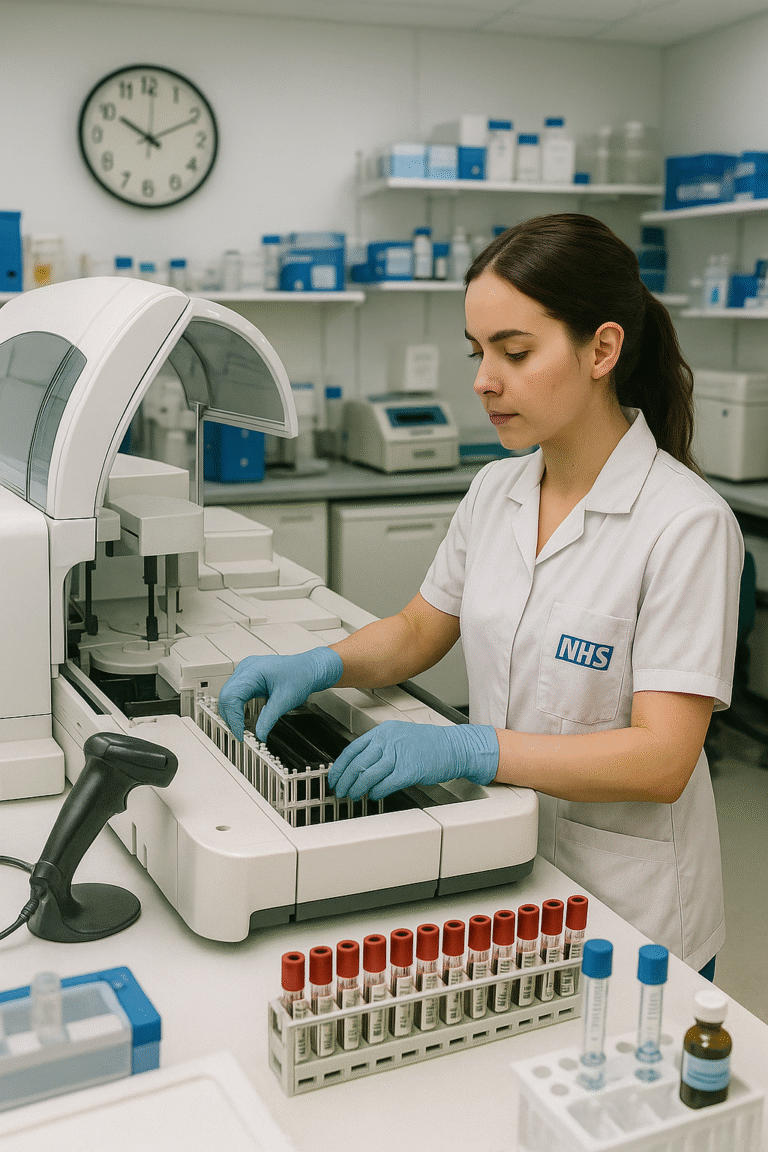The IBMS Registration Portfolio is a structured document that proves you are ready to become a Biomedical Scientist. It is your official pathway to HCPC registration, showing that you can work safely, ethically, and professionally in a medical laboratory.
Contents
What is the IBMS Registration Portfolio?
🔍 Self-Check: Match the Modules
Purpose and relevance for Biomedical Science students
📝 Overview of the HCPC Registration Process
Portfolio Structure and Format
Writing and Presenting Evidence
Justifying Evidence Against SoPs
Reflection and Continuous Improvement
🌟 Tips from Successful Trainees
📨 Final Preparation for HCPC Registration
Introduction
What is the IBMS Registration Portfolio?
The IBMS Registration Portfolio is a structured document that proves you are ready to become a Biomedical Scientist. It is your official pathway to HCPC registration, showing that you can work safely, ethically, and professionally in a medical laboratory.
It is not just a collection of tasks — it is a story of your training, showing your growth, learning, and ability to apply knowledge in real-life lab settings.
🏛️ Why Do I Need It?
In the UK, to work as a registered Biomedical Scientist, you must:
- Have a degree approved by the IBMS (or an equivalent qualification)
- Complete the IBMS Registration Training Portfolio
- Be assessed by an external IBMS verifier
- Get your Certificate of Competence to apply for HCPC registration
Without this portfolio, even if you have a science degree, you cannot legally work as a Biomedical Scientist under HCPC rules.
🧩 What Does It Contain?
The IBMS Registration Portfolio is made up of two sections, each containing five clearly defined modules. Each module includes:
- One mandatory evidence item
- Two candidate choice evidence items
- A defined set of HCPC SoPs that your evidence must map to
| Section | Focus | Modules |
| Section 1 | Professional Practice | 1. Personal Responsibility and Development 2. Equality, Diversity and Inclusion 3. Communication 4. Patient Records and Data Handling 5. Professional Relationships |
| Section 2 | Scientific and Clinical Practice | 1. Professional Knowledge 2. Health and Safety and Wellbeing 3. Quality 4. Performing Standard Investigations 5. Research and Development |
📎 Module Summary Table
| Section & Module | Focus Area | Examples of Evidence |
| S1:M1 – Personal Responsibility | Supervision, scope of practice, CPD | Personal statement on limits of practice, CPD log, HCPC role explanation |
| S1:M2 – Equality, Diversity, Inclusion | EDI application, unconscious bias, legislation | EDI case study, protected characteristics diagram, reflective summary |
| S1:M3 – Communication | Verbal/written/digital communication | Flowchart of communication methods, reflective blog, feedback loop diagram |
| S1:M4 – Patient Records & Data Handling | Consent, LIMS, confidentiality | Sample journey with data privacy, LIMS DOP, infographic on pre-analytical errors |
| S1:M5 – Professional Relationships | MDT work, leadership, collaboration | Reflective ward round summary, MDT feedback, summary of leadership observations |
| S2:M1 – Professional Knowledge | Physiology, pathology, disease knowledge | Case study with test results, review of test principles, disease-specific evaluation |
| S2:M2 – Health & Safety and Wellbeing | Risk assessment, PPE, stress management | Risk assessment form, wellbeing reflection, comparison of containment levels |
| S2:M3 – Quality | QC/QA, audit, accuracy | Audit summary, IQC/EQA summary, questionnaire on lab quality practices |
| S2:M4 – Performing Investigations | Techniques, SOP use, result interpretation | Statement of a standard investigation, annotated photo series, explanation of automation |
| S2:M5 – Research and Development | Research, problem-solving, experimental design | Lab-based project summary, literature review, evaluation of new methods/technologies |
🗺️ Portfolio Roadmap (Interactive Concept)
Let us create an analogy:
Imagine your portfolio as a journey through two cities:
- In City 1 (Section 1), you meet people, follow rules, and build relationships.
- In City 2 (Section 2), you work in labs, handle samples, assess quality, and design improvements.
Your passport stamps (evidence) prove where you have been and what you have learned — and must be linked to the laws of the land (HCPC SoPs).
🔍 Self-Check: Match the Modules
Can you correctly match these example activities to their corresponding modules?
| Activity | Correct Module |
| Writing a reflective statement on EQA performance | ✅ S2:M3 – Quality |
| Reviewing how you handled a religious EDI scenario | ✅ S1:M2 – Equality, Diversity and Inclusion |
| Describing your experience working with a POCT device | ✅ S1:M5 – Professional Relationships |
| Explaining the stages of glucose metabolism and diabetic ketoacidosis testing | ✅ S2:M1 – Professional Knowledge |
Purpose and relevance for Biomedical Science students
The IBMS Registration Portfolio is not just a training requirement — it is your gateway to professional status as a Biomedical Scientist in the UK.
Think of it as your “evidence passport” that shows you can:
- Work safely and ethically
- Apply your scientific knowledge in a real clinical setting
- Communicate, reflect, and improve your practice
- Collaborate with professionals and respect service users
Without completing this portfolio, you cannot legally register with the HCPC — even if you hold a Biomedical Science degree.
🎓 Who Needs to Complete It?
You must complete the IBMS Registration Portfolio if you:
- Hold an IBMS-accredited BSc (Hons) degree in Biomedical Science
- Or have a degree assessed by IBMS via the equivalence route
- Are working in an approved NHS or private pathology laboratory under supervision
📌 You will complete the portfolio during your Registration Training post, not during university.
🌍 How It Prepares You for Real-World Practice
| Academic Study | IBMS Registration Portfolio |
| Focuses on theory and assignments | Focuses on applying theory in practice |
| University-based learning | Lab-based, workplace-integrated training |
| Marks and grades | Reflective, evidence-based professional competence |
| Often generic to all biosciences | Tailored to your specific clinical laboratory environment |
You will bridge the gap between student and practitioner by:
- Using SOPs to justify your work
- Reflecting on ethical decisions and patient care
- Recording training that aligns with national standards
📝 Overview of the HCPC Registration Process
🔑 What is the HCPC?
The Health and Care Professions Council (HCPC) is the UK regulatory body for 15 healthcare professions — including Biomedical Scientists. Its role is to protect the public by ensuring that professionals are trained, competent, and ethical.
📋 Step-by-Step: How to Register as a Biomedical Scientist
| Step | Action |
| 1️⃣ | Complete an IBMS-accredited degree (or gain equivalence) |
| 2️⃣ | Complete the IBMS Registration Portfolio (Version 5.0) in an approved laboratory |
| 3️⃣ | Pass internal verification and external IBMS assessment |
| 4️⃣ | Receive the IBMS Certificate of Competence |
| 5️⃣ | Apply online for HCPC registration and pay the fee |
| 6️⃣ | Receive your HCPC registration number — now legally a Biomedical Scientist! |
📌 HCPC Registration Checklist
✔️ IBMS Certificate of Competence
✔️ Degree certificate
✔️ Proof of ID
✔️ Character reference
✔️ Application fee
✔️ Completed online application form
Portfolio Structure and Format
The IBMS Registration Training Portfolio (Version 5.0) is a formal collection of workplace-based evidence. It is built to show that you meet the HCPC Standards of Proficiency (2023) required for safe, independent practice as a Biomedical Scientist.
🧱 Portfolio Framework
The portfolio is divided into two sections, with five modules each.
| Section | Title | Focus |
| Section 1 | Professional Conduct | Your values, responsibility, communication, and relationships |
| Section 2 | Professional Practice | Your scientific knowledge and technical competency |
📘 Section 1 – Professional Conduct (Modules 1–5)
| Module | Title | Key Themes |
| S1:M1 | Personal Responsibility and Development | CPD, ethical conduct, reflective practice |
| S1:M2 | Equality, Diversity and Inclusion | Legislation, bias, dignity, protected groups |
| S1:M3 | Communication | Written, verbal, digital communication |
| S1:M4 | Patient Records and Data Handling | Confidentiality, LIMS, consent, governance |
| S1:M5 | Professional Relationships | MDT working, leadership, collaborative learning |
🔬 Section 2 – Professional Practice (Modules 1–5)
| Module | Title | Key Themes |
| S2:M1 | Professional Knowledge | Disease mechanisms, test interpretation, diagnostics |
| S2:M2 | Health and Safety and Wellbeing | Risk assessments, PPE, wellbeing, containment levels |
| S2:M3 | Quality | QC/QA, audits, clinical governance |
| S2:M4 | Performing Standard Investigations | SOPs, data analysis, sample processing |
| S2:M5 | Research and Development | Experimental design, novel data, literature review |
📄 Evidence Requirements
Each module contains:
- 1 Mandatory Evidence: A structured task you must complete
- 2 Candidate’s Choice Evidences: You select tasks that meet the remaining SoPs
Each piece of evidence must include:
✔️ Description of the task
✔️ Justification showing how it meets relevant SoPs
✔️ Reflective commentary
✔️ Supporting documents or attachments (e.g. SOPs, screenshots, diagrams)
- Overview of Sections, Modules, and Evidence
- Mapping to HCPC Standards of Proficiency (SoPs)
- Using OneFile or paper-based formats
Getting Started
Before diving into writing evidence, you should understand the key roles, initial steps, and tools involved in completing the IBMS Registration Portfolio effectively.
🔑 Step 1: Understand the Key Roles
| Role | Responsibility |
| Candidate (You) | Collect, write, and justify evidence that proves you meet the HCPC SoPs |
| Training Officer | Supports your training, guides evidence writing, and checks portfolio progress |
| Verifier (Internal) | Reviews all evidence before submission to ensure it meets standards |
| IBMS External Assessor | Visits (or reviews online) to verify your competence and recommend certification |
📌 Tip: Build a good relationship with your Training Officer — they are your main support throughout.
🗓️ Step 2: Induction and Training Plan
At the start of your placement:
- You should have an induction to the department and its processes
- Your Training Officer should help create a training plan, often broken down by module or rotation
- Discuss expectations, milestones, and preferred formats for evidence (OneFile or paper)
📋 Step 3: Use Your Tools
| Tool | Purpose |
| Module Descriptor | Lists all evidence tasks and the exact SoPs they must meet |
| SoP Mapping Matrix | Helps you track which SoPs have been covered |
| OneFile | Digital platform for uploading, tagging, and receiving feedback |
| Lab SOPs / Policies | Essential for writing justifications that show safe, compliant practice |
📌 Top Tips Before You Start
- Read the descriptor before attempting any evidence
- Keep a journal or CPD log as you go — it helps with reflection
- Tag evidence carefully using the correct HCPC SoPs
- Back up your work regularly (especially if not using OneFile)
Writing and Presenting Evidence
Your portfolio evidence is the heart of your registration — it is where you prove that you understand, apply, and reflect on real-world laboratory practice in line with HCPC Standards of Proficiency (SoPs).
📄 What Makes Good Evidence?
Good evidence is:
✅ Authentic – comes from your own experience
✅ Relevant – directly related to the task and mapped SoPs
✅ Structured – clearly written and logically organised
✅ Reflective – includes what you learned and how you grew
✅ Justified – explains how the work meets the SoP
🧱 Basic Structure of an Evidence Entry
You can follow this layout (especially useful in OneFile or paper portfolios):
| Section | What to Include |
| Title | Clear name of the task (e.g. “Reflection on Ward Round – S1:M5”) |
| SoPs Covered | List of mapped SoP numbers (e.g. 8.1, 8.13) |
| Description | What happened, what you did, tools or protocols used |
| Justification | How your actions meet the SoPs, with specific reference to standard language |
| Reflection | What went well, what you learned, and how it affected your future practice |
| Supporting Docs | Attachments like SOPs, screenshots, audits, training records (if required) |
🧠 Models to Help You Write
Use these models to guide your writing and reflection:
⭐ STAR Model (for action-based evidence)
- Situation – context of the event
- Task – what you needed to do
- Action – what you actually did
- Result – what happened, including your learning outcome
🔄 What? So What? Now What? (for reflection)
- What? – Describe the experience
- So What? – Why was it important? What did you learn?
- Now What? – How will this affect your future behaviour?
✏️ Tips for Clear and Effective Writing
🟦 Use plain English, but avoid overly casual language
🟦 Use past tense to describe what you did
🟦 Avoid generic statements like “I followed the SOP” — explain how and why
🟦 Do not copy and paste text from SOPs or policies — show your own understanding
🟦 Use headers and bullet points to break up long text
🖼️ Visual Evidence Ideas
You can use diagrams and illustrations where appropriate, for example:
- A flowchart of the specimen journey for S1:M4 (Data Handling)
- A poster showing protected characteristics for S1:M2 (EDI)
- A table comparing containment levels for S2:M2 (Health and Safety)
- A photograph series of analyser calibration for S2:M3 (Quality)
📌 Be sure to anonymise all images (e.g. no patient names, IDs, or staff initials).
🧪 Example (Using STAR)
S: I was asked to validate a new batch of troponin reagents on the analyser.
T: I had to run QC materials and check results against previous batches.
A: I followed the SOP for analyser validation, recorded results, and discussed findings with the senior BMS.
R: I confirmed that the batch was performing within acceptable limits. This evidence supports SoP 13.20 and 13.14 because it shows that I can carry out and validate quality control procedures to maintain service accuracy.
Justifying Evidence Against SoPs
Writing a justification is a key part of your evidence. It is where you clearly explain how your task proves that you meet one or more HCPC Standards of Proficiency (SoPs).
You are not just showing what you did — you are showing why it matters professionally.
🔍 What is a Justification?
A justification links your practical experience to the professional standard. It explains:
- What you did
- Why you did it
- How this proves you meet a specific SoP
Think of it as a mini-argument: “Here is the task I completed — and here is why it demonstrates professional competence.”
“I [action you took], which demonstrates SoP [number] because [explanation linking your action to the standard].”
🧠 Examples
Example 1 – S1:M1, SoP 4.1 – Personal Responsibility
“I refused to proceed with a potassium test when the sample was visibly clotted. I sought guidance from a senior and recorded the rejection in LIMS. This shows that I am personally responsible for my decisions and can justify them in line with SoP 4.1.”
Example 2 – S1:M2, SoP 5.3 – Respect for Diversity
“During my training, I ensured appropriate language was used when preparing patient leaflets. I considered how gendered or culturally biased terms could affect inclusivity. This demonstrates SoP 5.3, as I actively recognised and reduced personal bias in my communication.”
Example 3 – S2:M2, SoP 14.3 – Risk Management
“I created a COSHH risk assessment for Xylene use in Histology. I identified hazards, applied controls, and discussed outcomes with the health and safety officer. This reflects SoP 14.3, as it shows my ability to assess risks and apply control measures appropriately.”
✅ Checklist for a Good Justification
| ✅ Element | ✔️ Present? |
| States the task or activity | |
| Mentions the specific SoP number | |
| Uses wording from the SoP itself | |
| Explains how the task meets the SoP | |
| Includes personal reflection |
💡 Use the SoP descriptors in the Module Descriptor — they contain key phrases that should appear in your justification.
Reflection and Continuous Improvement
Reflection is more than just thinking about what happened — it is about learning from experience and using that learning to improve your practice. This is a critical requirement for all healthcare professionals, especially under HCPC SoP 10.1.
🔁 Why is Reflection Important?
| Reflection Helps You… | Because… |
| Identify what went well and what could improve | You learn from both success and mistakes |
| Understand how actions impact others | You become more ethical, safe, and person-centred |
| Develop professional judgement | You make better decisions in complex or pressured situations |
| Show growth over time | You demonstrate maturity and readiness for independent practice |
📘 HCPC SoP 10.1
“Understand the value of reflective practice and the need to record the outcome of such reflection to support continuous improvement.”
To meet this SoP, you must include reflections throughout your portfolio, not just in a single module.
🧠 Reflective Models (Pick One and Be Consistent)
🔄 What? So What? Now What? (Great for short reflections)
- What? – Describe what happened
- So What? – Why does it matter? What did you learn?
- Now What? – What will you do differently next time?
⭐ STAR (For experience-based evidence)
- Situation – What was the context?
- Task – What did you have to do?
- Action – What did you actually do?
- Result – What was the outcome or learning point?
✍️ Example Reflection
“What? I helped interpret an urgent potassium result for ITU and phoned it through to the consultant. So What? I realised how critical lab results can be for patient decisions. Now What? I will double-check urgent results before reporting and ensure clear documentation in LIMS. This reflection shows my growth in responsibility and communication.”
Mapped to: S1:M3 (Communication) and SoP 7.9 (Communicating outcomes)
📌 Where to Include Reflection
Reflection can appear in:
✔️ Mandatory or candidate-choice evidence
✔️ Personal statements (e.g. S1:M1, S1:M5)
✔️ CPD logs (e.g. S1:M1)
✔️ Research write-ups (e.g. S2:M5)
🧠 Do not just describe — reflect on your actions, decisions, and learning.
💻 Using OneFile Effectively
OneFile is a widely used digital platform for managing and submitting your IBMS Registration Portfolio. IBMS Registration Portfolio V-5 can only be completed using OneFile platform.
🧭 Why Use OneFile?
- Keeps all evidence in one secure location
- Allows tagging of SoPs and modules
- Enables feedback from Training Officers and Verifiers
- Tracks your progress across the portfolio
🖱️ Basic Navigation for Candidates
| Action | Where to Go in OneFile |
| Upload evidence | Click on “+ New Evidence” under your portfolio dashboard |
| Tag HCPC SoPs | Select relevant SoPs when uploading or editing evidence |
| Assign to a module | Choose the correct module (e.g. S1:M2 – EDI) |
| Feedback and comments | Provide justification under feedback and comments section. |
| Track progress | Use the “Progress” tab to see completed vs. pending tasks |
📘 Refer to IBMS OneFile Candidate User Guide for step-by-step screenshots.
📂 Naming and Organising Files
| Good Practice | ✅ Example |
| Use clear evidence titles | “Evidence 3 – LIMS and Consent – S1:M4” OR S1M1E3 |
| Indicate which SoPs are covered | Check boxes as appropriate from SoPs list |
| Attach relevant documents | Screenshots, SOPs, diagrams, anonymised data |
⚠️ Common Mistakes to Avoid
🚫 Uploading evidence without tagging SoPs
🚫 Tagging too many SoPs that are not truly demonstrated
🚫 Forgetting to write justification
🚫 Failing to label evidence clearly or linking it to the wrong module
✅ OneFile Quick Tips
- Write your justification before uploading — then paste it in
- Keep a checklist of SoPs to track which ones are complete
- Use “Save as Draft” if your work is not yet ready for review
- Regularly review feedback from your Training Officer and respond promptly
🔍 The Verification and Final Assessment Process
Once you complete your portfolio, it must be assessed to confirm that you have met all the HCPC Standards of Proficiency (SoPs). This happens in two stages: internal verification and external IBMS assessment.
🧑💼 Stage 1: Internal Verification
Your Verifier (often your Training Officer or local training lead) will:
- Check that all 10 modules are complete
- Ensure each mandatory and candidate-choice evidence item is included
- Confirm that all SoPs are covered
- Provide feedback and request edits if needed
✅ Only after this review is the portfolio ready for submission to IBMS.
👩⚖️ Stage 2: IBMS External Assessment
An IBMS External Assessor will:
- Review your evidence and justifications in detail
- Conduct a professional discussion (usually virtually or on-site)
- Ask questions about how you meet the SoPs in practice
- Confirm whether your portfolio meets the required standard
If successful, you will receive the IBMS Certificate of Competence — the final step before applying to the HCPC.
🚫 Common Reasons for Referral
| ❌ Issue | 💡 How to Avoid It |
| SoPs not fully covered | Use the SoP Mapping Matrix to track them carefully |
| Evidence lacks depth or reflection | Use STAR or What/So What/Now What models |
| Overuse of generic statements | Focus on your role, not what “the lab” does |
| Missing attachments or anonymisation | Double-check uploads and remove patient identifiers |
🧠 Tip from Assessors
“We are not looking for perfection — we are looking for honest, thoughtful, safe practice, and a willingness to reflect and grow.”
🌟 Tips from Successful Trainees
Based on feedback from previous portfolio candidates, assessors, and Training Officers, these tips can help you save time, avoid mistakes, and submit with confidence.
⏳ 1. Start Early — Do Not Wait!
📌 “I thought I had time, but the portfolio took longer than I expected.”
Begin collecting evidence from your first few weeks in training. Simple tasks like SOP readings, observations, and competency logs are valid early evidence.
📋 2. Use a Checklist to Track SoPs and Modules
Print the SoP Mapping Matrix and tick off each SoP as you address it.
| ✅ Tool | 📎 Use It For |
| SoP Mapping Matrix | Tracking coverage of HCPC standards |
| Module Descriptor | Understanding what each module asks of you |
| Training Plan Template | Scheduling evidence and observations |
✍️ 3. Be Specific in Your Justifications
Avoid vague comments like “I followed the SOP.” Instead, say:
“I followed SOP Kit insert for urea and electrolytes, recording batch numbers and validating controls. This meets SoP 13.20.”
🪞 4. Reflect Little and Often
Do not wait until the end to reflect. Use short reflection notes:
- After training sessions
- Following errors or improvements
- When learning from others
A monthly CPD log can feed directly into your evidence (especially S1:M1 and S2:M5).
💬 5. Ask for Feedback Regularly
“I kept uploading, but I forgot to request feedback!”
Use OneFile’s feedback request tool — or email your Training Officer — to get timely guidance and avoid having to rewrite large sections at the end. Arrange regular meetings with your Training officer.
📦 6. Use Real Lab Tasks as Evidence
| 💡 Routine Task | 📁 Possible Module |
| Completing a COSHH risk assessment | S2:M2 – Health and Safety and Wellbeing |
| Responding to an IQC failure | S2:M3 – Quality |
| Reflecting on a communication error | S1:M3 – Communication |
| Presenting at a team huddle | S1:M5 – Professional Relationships |
Even simple daily tasks can demonstrate SoPs if you explain your thinking, actions, and learning.
📌 7. Keep it Manageable
Set small, weekly targets. For example:
| Week | Goal |
| Week 1 | Complete S1:M1 mandatory evidence draft |
| Week 2 | Write justification and upload with SoPs |
| Week 3 | Request feedback from Training Officer |
Break the portfolio into manageable steps to avoid being overwhelmed.
📨 Final Preparation for HCPC Registration
Once you have completed and passed the IBMS Registration Portfolio, the final step is to apply for registration with the Health and Care Professions Council (HCPC) — the regulator for Biomedical Scientists in the UK.
🏁 What Happens After Your Portfolio Is Signed Off?
- Your internal verifier confirms portfolio completion
- The IBMS External Assessor approves and signs off your portfolio
- You are awarded the IBMS Certificate of Competence
📌 This certificate proves that you are safe, competent, and ready to practise as a Biomedical Scientist.
🖥️ Applying to the HCPC
You must then submit an online application to the HCPC via their website:
👉 https://www.hcpc-uk.org
📋 HCPC Application Checklist
✅ IBMS Certificate of Competence (from IBMS)
✅ Degree certificate (accredited or confirmed as equivalent)
✅ Proof of identity (e.g. passport, driving licence)
✅ Character reference
✅ Completed HCPC application form
✅ Payment of registration fee (approx. £120 per year*)
*HCPC fees are subject to change — check their website for latest updates.
⏱️ How Long Does It Take?
The HCPC aims to process most applications within 10–20 working days after receiving all documentation.
Once approved, your name will appear on the HCPC Register under “Biomedical Scientist.”
🎉 You Are Now a Biomedical Scientist!
Once registered, you can:
- Use the protected title: Biomedical Scientist
- Apply for Band 5 roles in the NHS ( unless were already employed as Trainee BMS)
- Start planning for IBMS Specialist Portfolios or postgraduate qualifications
Sign up for free class
It’s easy and free!










